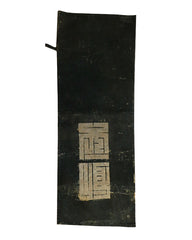A Deerskin Bag from the Edo Period: dated Ansei 6 or 1860
dated 1860
20" x 7 3/4", 51 cm x 19.5 cm
This is a bag that is made of deerskin that has been stenciled with dye and shows two, stacked stylized kanji or Chinese characters on front and back.
The soft deerskin used in the laborious hand-manufacture of this elegant accessory was imported, it is not from Japan.
Some say the deerskin comes from China or Southeast Asia while it seems a more accepted notion that the deerskin used in Japan was Indian. The exotic origin of this rare material only compounds the importance of this as a specialized, covetable object which was no doubt owned by a person of means.
As some of you may be familiar there are well-known examples of boldly patterned leather fireman's coats. In addition to making garments from leather, accessories were also made, such as this bag and another that was sold here a short while ago.
What is rather amazing about this bag is that it is inscribed on the inside. The writing translates to "Ansei 6, Auspicious Day." Ansei is the name of a era within the broader Edo period, Ansei spans the period of almost six years, from November 1854 and ending in March 1860.
The bag is in poor condition, the reverse side of this bag is quite battered. But still, this is a precious object which is made even more precious from the documentation of it that is written inside.
The bag is of a shape and size referred to as a zenibukuro or "money bag." This name is attributed to bags of this form as in the past coins were minted with a center hole and many heavy coins would be strung together to form long garlands. The shape of this kind of bag accommodated these long, heavy strands of money although we do not know if this particular bag was used for that purpose. Judging from the absence of abrasion to the inside of the bag we can assume it was not. And from that we can assume the heavy abrasion to the outside of the bag was from storage, or poor keeping.
This is a treasure.
Recommended.


